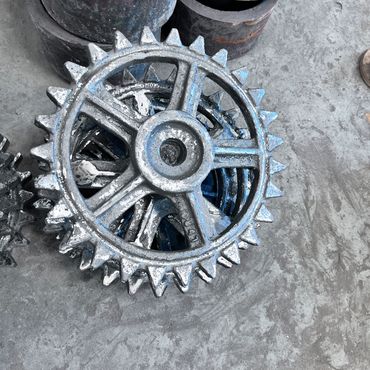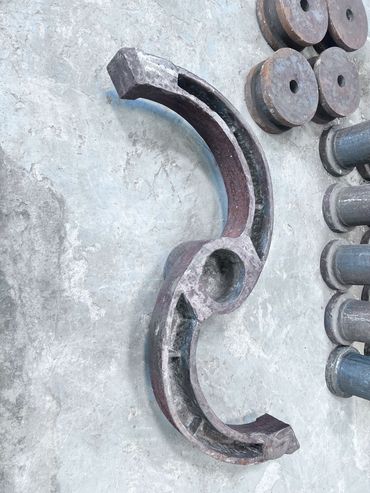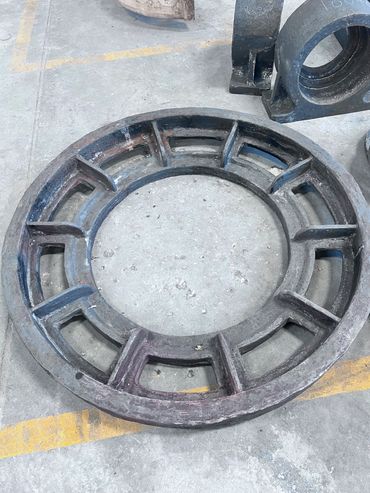About STAMMFORD CEMENTING & ALLOYS

Our Story
We take this opportunity to introduce Stammford Cementing & Alloys, a trusted name in the field of sand casting of stainless steel and alloys. Experienced since 1974, our company has been serving diverse industries with precision-engineered castings backed by decades of experience and continuous technological advancement.
Our manufacturing facilities are equipped with:
- Induction Furnaces with crucibles of 150 kg, 300 kg, and 500 kg capacity.
- Spectrometer for precise chemical analysis and quality assurance.
- Heat Treatment Facilities to achieve the required mechanical properties.
- Shot Blasting Machines for surface finishing.
With a legacy of nearly five decades in casting excellence, we specialise in producing high-quality stainless steel and alloy components for applications in Oil & Gas, Engineering, Automotive, Valves, Pumps, etc. (stainless steel castings steel & alloy castings stainless steel casting foundry)

About Us
Our Vision
Our Vision
Stammford Cementing & Alloys. stands as a testament to decades of engineering excellence and innovation. Established in 2025, our company is built on the solid foundation of expertise that dates back to 1974 in the realm of engineering manufacturing. Our journey began with a steadfast commitment to quality and precision, which continues t
Stammford Cementing & Alloys. stands as a testament to decades of engineering excellence and innovation. Established in 2025, our company is built on the solid foundation of expertise that dates back to 1974 in the realm of engineering manufacturing. Our journey began with a steadfast commitment to quality and precision, which continues to define our operations today. (stainless steel castings steel & alloy castings stainless steel casting foundry)

Our Vision
Our Vision
Our Vision
To be the forefront of technological advancements in engineering, setting new benchmarks for quality, reliability, and innovation. We aspire to contribute significantly to the success of our clients by consistently delivering products that exceed expectations. (stainless steel castings stainless steel casting foundry steel & alloy castings)

What We Do
Our Vision
What We Do
Steel and alloy casting is a manufacturing process used to produce parts and components by pouring molten metal into molds. This process is crucial in many industries, including automotive, aerospace, construction, oil & gas and machinery. (stainless steel castings steel & alloy castings stainless steel casting foundry)
MATERIAL GRADES

Indian Standards Grades
- IS 1030 ASTM 216
- IS 2708 ASTM A 353
- IS 8630 ASTM A 9955
- IS 4896 ASTM A 743
- IS 4896 ASTM A 532 CA 6 NM
- IS 2707
- IS 3856
- M-16
EN Steel Grades
- EN-3
- EN-8
- EN-19
- EN-24
- EN-25
- EN-31
- EN-353
- EN-10293
Stainless Steel Grades
- SS-304
- SS-304L
- SS-310
- SS-316 L
- SS 410
Casting Process at Stammford
Sand Casting Process – Stainless Steel & Alloys
1. Pattern Making
o A pattern (wood, metal, or resin) is created in the shape of the final component, considering shrinkage allowance.
2. Mold Preparation
o Special foundry sand (silica, zircon, or chromite with binders) is packed around the pattern in a flask (molding box).
o The pattern is removed, leaving a cavity in the shape of the casting.
3. Core Making (if required)
o Cores are made of sand to form internal cavities or complex hollow sections inside the casting.
4. Mold Assembly
o The mold halves and cores are assembled, including gating and riser systems for molten metal flow and feeding.
5. Melting & Pouring
o Steel or alloy is melted in an induction or arc furnace.
o Molten metal is poured into the mold cavity through the gating system.
6. Solidification & Cooling
o The molten metal solidifies into the desired shape inside the sand mold.
7. Shakeout & Fettling
o Once cooled, the mold is broken (shakeout) to remove the casting.
o Excess metal (gates, risers) is cut off, and the surface is cleaned by shot blasting, grinding, or machining.
8. Inspection & Testing
o Castings are inspected visually and dimensionally.
o Non-destructive tests (NDT) like radiography, ultrasonic testing, or magnetic particle inspection may be done for critical parts.
Product Range at Stammford
Our Product Range Includes:
- Pump Components – casings, impellers, volutes, covers
- Valve Components – bodies, bonnets, discs, seats
- Oil & Gas / Petrochemical Parts – flanges, housings, connectors, flow control components
- Power & Energy Equipment – turbine casings, bearing housings, gear housings
- Engineering & Heavy Machinery – machine bases, brackets, manifolds, couplings, hubs
- Marine & Defense Applications – propeller hubs, deck fittings, structural parts.
Extended Product Range
Pumps & Flow Equipment
- Pump casings (end suction, split casing, multistage)
- Impellers (closed, semi-open, open type)
- Volutes & diffusers
- Pump covers & glands
Valves & Fittings
- Gate, globe, check, and ball valve bodies
- Bonnet covers
- Valve discs, seats, and wedges
- Y-strainer bodies
- Industrial pipe fittings (tees, elbows, reducers, flanges)
Oil, Gas & Petrochemical
- Compressor housings
- Drill bit housings
- Flow tees and manifolds
- Couplings & collars
- High-pressure flanges and adapters
Power & Energy
- Turbine casings
- Bearing housings
- Gear box housings
- Generator brackets & end shields
Marine & Offshore
- Propeller hubs & blades (semi-finished)
- Deck equipment & brackets
- Mooring hardware & fixtures
General Engineering & Machinery
- Machine tool bases & supports
- Clutch housings
- Flywheels
- Shafts, hubs, and couplings
- Brackets, levers, and frames
Specialty / Custom Castings
- Heat-resistant components (furnace parts, grates, burners)
- Wear-resistant liners & plates
- Agricultural machinery parts
- Mining equipment castings (crusher parts, liners)

Certifications
OCCUPATIONAL HEALTH & SAFETY MANAGEMENT SYSTEM
OCCUPATIONAL HEALTH & SAFETY MANAGEMENT SYSTEM
OCCUPATIONAL HEALTH & SAFETY MANAGEMENT SYSTEM

An Occupational Health & Safety Management System is a structured framework that helps organizations identify, control, and reduce risks related to workplace health and safety. Its goal is to ensure the well-being of employees, contractors, and visitors while maintaining compliance with legal and regulatory requirements.
QUALITY MANAGEMENT SYSTEM
OCCUPATIONAL HEALTH & SAFETY MANAGEMENT SYSTEM
OCCUPATIONAL HEALTH & SAFETY MANAGEMENT SYSTEM

A Quality Management System is a structured framework of policies, processes, and procedures that ensures an organisation consistently delivers products and services that meet customer and regulatory requirements.
HEALTH & SAFETY
Safe envoirment , better quality ....
Our organisation is committed to providing a safe and healthy workplace for all employees, contractors, and visitors. We aim to prevent accidents, injuries, and work-related illnesses by maintaining high safety standards, promoting awareness, and adhering to applicable health and safety regulations. Everyone is responsible for contributing to a safe working environment.

Images






Images






Images






My Blog
Importance of Stainless Steel

Importance of SS Casting products
Importance of SS 304, SS 316 & SS 410 Stainless Steels
1. SS 304 – The Most Versatile Stainless Steel
Importance:
SS 304 is the most commonly used stainless steel because of its excellent corrosion resistance, formability, and weldability. It offers a great balance between cost and performance.
Key Uses:
- Food & beverage industry (equipment, tanks, pipes)
- Architectural and structural applications
- General industrial fabrication and machinery
- Household and kitchen equipment
Why It’s Important:
- Reliable in most atmospheric and mild chemical environments.
- Easy to fabricate and maintain.
- Cost-effective and widely available.
2. SS 316 – The Marine & Chemical Grade
Importance:
SS 316 is known for its superior corrosion resistance, especially against chlorides, saltwater, and aggressive chemicals. The addition of molybdenum (2%) makes it ideal for harsh environments.
Key Uses:
- Marine & offshore components
- Chemical and pharmaceutical processing equipment
- Heat exchangers and condensers
- Medical instruments
Why It’s Important:
- Resists pitting and crevice corrosion.
- Performs exceptionally in marine and chemical industries.
- Ensures long life and reliability in severe conditions.
3. SS 410 – The Strength & Wear-Resistant Grade
Importance:
SS 410 is a martensitic stainless steel valued for its high strength, hardness, and wear resistance after heat treatment. It’s suitable for parts exposed to mechanical stress and moderate corrosion.
Key Uses:
- Pump shafts, turbine blades, and valve parts
- Cutlery and tools
- Automotive and industrial equipment
- Components requiring hardness with some corrosion protection
Why It’s Important:
- Provides excellent mechanical strength.
- Can be heat-treated for desired hardness levels.
- Ideal for moving or load-bearing components.
Contact Us: info@stammfordcementing.com
Address: Plot no.127, Sector-25, Faridabad, Haryana, India-121004, +91- 8860087012
We love our cutomers, so feel free to visit during normal business hours.
Hours
Open today | 09:00 am – 05:00 pm |
This website uses cookies.
We use cookies to analyze website traffic and optimize your website experience. By accepting our use of cookies, your data will be aggregated with all other user data.

